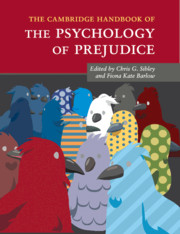Book contents
- Frontmatter
- Dedication
- Contents
- List of Figures
- List of Tables
- Notes on the Contributors
- Part I General Theoretical Perspectives
- Part II Prejudice in Specific Domains
- 11 Understanding the Nature, Measurement, and Utility of Implicit Intergroup Biases
- 12 Aversive Racism and Contemporary Bias
- 13 Ambivalent Sexism in the Twenty-First Century
- 14 Sexism in Intimate Contexts: How Romantic Relationships Help Explain the Origins, Functions, and Consequences of Sexist Attitudes
- 15 Religion and Prejudice
- 16 Sexual Prejudice: Advances in Conceptual and Empirical Models
- 17 Weight Bias: Prejudice and Discrimination toward Overweight and Obese People
- 18 Prejudice Against Immigrants in Multicultural Societies
- 19 Generalized Prejudice: Old Wisdom and New Perspectives
- Part III Prejudice Reduction and Analysis in Applied Contexts
- Index
- References
15 - Religion and Prejudice
from Part II - Prejudice in Specific Domains
Published online by Cambridge University Press: 17 November 2016
- Frontmatter
- Dedication
- Contents
- List of Figures
- List of Tables
- Notes on the Contributors
- Part I General Theoretical Perspectives
- Part II Prejudice in Specific Domains
- 11 Understanding the Nature, Measurement, and Utility of Implicit Intergroup Biases
- 12 Aversive Racism and Contemporary Bias
- 13 Ambivalent Sexism in the Twenty-First Century
- 14 Sexism in Intimate Contexts: How Romantic Relationships Help Explain the Origins, Functions, and Consequences of Sexist Attitudes
- 15 Religion and Prejudice
- 16 Sexual Prejudice: Advances in Conceptual and Empirical Models
- 17 Weight Bias: Prejudice and Discrimination toward Overweight and Obese People
- 18 Prejudice Against Immigrants in Multicultural Societies
- 19 Generalized Prejudice: Old Wisdom and New Perspectives
- Part III Prejudice Reduction and Analysis in Applied Contexts
- Index
- References
Summary
From a religious point of view, if God had thought homosexuality is a sin, he would not have created gay people.
Howard Dean, Former Governor of VermontIf a man has sexual relations with a man as one does with a woman, both of them have done what is detestable. They are to be put to death; their blood will be on their own heads.
Leviticus 20:13, New International VersionA woman helps feed and clothe poor children in the slums of India: How likely is it that her religion motivated her to do so? A man votes against marriage equality for gay men and lesbians: How likely is it that his religion motivated him to do so? As Allport (1954) noted more than half a century ago, religion has a paradoxical relationship with prejudice. In his words, “[religion] makes and unmakes prejudice.” In the more than six decades since Allport made this observation, social psychologists have tried to pin down the precise relationship between religion and prejudice.
Early work in this area attempted to fractionate religion into distinct components that respectively predicted more and less prejudice. In this view, some “core” element of religion may predict tolerance, while other aspects of religion (or nonreligious constructs that tend to nonetheless correlate with religiosity) might engender outgroup enmity. This tradition has a long history, indeed, as William James (1902) noted:
The plain fact is that men's minds are built, as has been often said, in water-tight compartments. Religious after a fashion, they yet have many other things in them beside their religion, and unholy entanglements and associations inevitably obtain. The basenesses so commonly charged to religion's account are thus, almost all of them, not chargeable at all to religion proper, but rather to religion's wicked practical partner, the spirit of corporate dominion. And the bigotries are most of them in their turn chargeable to religion's wicked intellectual partner, the spirit of dogmatic dominion, the passion for laying down the law in the form of an absolutely closed-in theoretic system.
This search for “religion proper” and the unfortunate “wicked practical partners” of religiosity dominated research on religion and prejudice for decades.
- Type
- Chapter
- Information
- The Cambridge Handbook of the Psychology of Prejudice , pp. 344 - 370Publisher: Cambridge University PressPrint publication year: 2016
References
- 2
- Cited by



